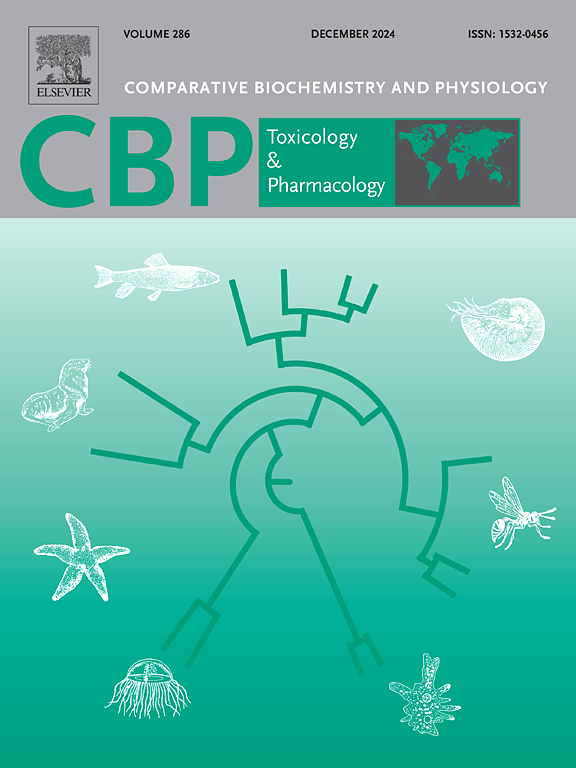二甲双胍对挥发性有机化合物诱导的斑马鱼胚胎发育毒性的保护作用
IF 4.3
3区 环境科学与生态学
Q2 BIOCHEMISTRY & MOLECULAR BIOLOGY
Comparative Biochemistry and Physiology C-toxicology & Pharmacology
Pub Date : 2025-06-09
DOI:10.1016/j.cbpc.2025.110250
引用次数: 0
摘要
挥发性有机化合物(VOCs)是广泛存在的环境污染物,与各种健康风险有关,包括发育毒性。我们之前的研究揭示了室内voc暴露与先天性心脏病(CHDs)风险增加之间的相关性,并通过建立斑马鱼暴露模型证实了这一点。二甲双胍(Metformin, MET)是一种经典的降糖药物,具有多种特性。在对二甲双胍对空气污染的保护作用研究的基础上,我们提出了二甲双胍对vocs诱导的斑马鱼胚胎发育毒性具有保护作用的假设,并探讨了其分子机制。将斑马鱼胚胎单独或联合不同浓度的MET(0.5、1.0和2.0 mg/mL)暴露于VOCs混合物(128 mg/L)中120 h, MET显著减轻了斑马鱼胚胎的成活率、孵化率和形态异常(脊柱弯曲、卵黄囊水肿和体长缩短),尤其是浓度为0.5 mg/mL时。MET治疗有效地减轻了心血管损伤(心包水肿和心动过缓)和神经发育缺陷(运动活动)。转录组学分析显示met介导的凋亡相关基因和细胞周期调节因子的调节。通路分析发现神经发育和心血管功能显著富集,吖啶橙染色显示细胞凋亡减少。我们的研究结果表明,MET对vocs诱导的发育毒性具有抗凋亡保护作用,这表明它有可能成为一种新的污染相关发育障碍的治疗干预手段。本文章由计算机程序翻译,如有差异,请以英文原文为准。

Protective effects of metformin against volatile organic compounds-induced developmental toxicity in zebrafish embryos
Volatile organic compounds (VOCs) are widespread environmental pollutants associated with various health risks, including developmental toxicity. Our previous studies revealed a correlation between indoor VOCs exposure and an increased risk of congenital heart diseases (CHDs), which was confirmed by establishing a zebrafish exposure model. Metformin (MET), a classic hypoglycemic drug, has been identified to possess multiple properties. Based on previous research on the protective effects of metformin on air pollution, we propose a hypothesis of using metformin as protective agent against VOCs-induced developmental toxicity in zebrafish embryos and explore the underlying molecular mechanisms.
The zebrafish embryos were exposed to the VOCs mixture (128 mg/L) alone or in combination with different concentrations of MET (0.5, 1.0 and 2.0 mg/mL) for 120 h. Toxicological indicators such as survival rate, hatching rate and morphological abnormalities (spinal curvature, yolk sac edema and body length reduction) were significantly alleviated by MET, especially in concentrations of 0.5 mg/mL. MET treatment effectively mitigated both cardiovascular impairments (pericardial edema and bradycardia) and neurodevelopmental deficits (locomotor activity). Transcriptomic profiling revealed MET-mediated modulation of apoptosis-related genes and cell cycle regulators. Pathway analyses identified significant enrichment in neurodevelopmental and cardiovascular functions, corroborated by acridine orange staining showing reduced apoptosis.
Our findings demonstrate MET's anti-apoptotic protection against VOCs-induced developmental toxicity, suggesting its potential as a novel therapeutic intervention for pollution-related developmental disorders.
求助全文
通过发布文献求助,成功后即可免费获取论文全文。
去求助
来源期刊
CiteScore
7.50
自引率
5.10%
发文量
206
审稿时长
30 days
期刊介绍:
Part C: Toxicology and Pharmacology. This journal is concerned with chemical and drug action at different levels of organization, biotransformation of xenobiotics, mechanisms of toxicity, including reactive oxygen species and carcinogenesis, endocrine disruptors, natural products chemistry, and signal transduction with a molecular approach to these fields.

 求助内容:
求助内容: 应助结果提醒方式:
应助结果提醒方式:


